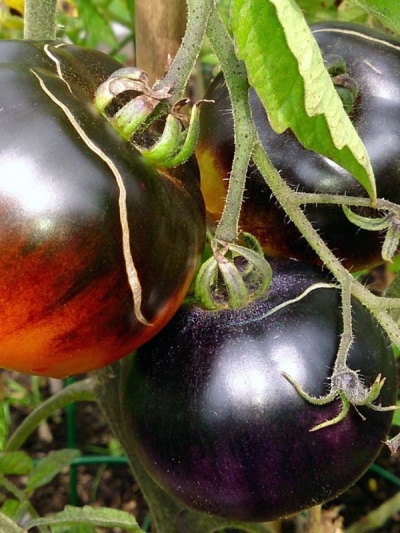
- Authors: Oregon State University (OSU)
- Category: grade
- Growth type: indeterminate
- Appointment: fresh consumption, for pickling and preserving
- Ripening period: mid-season
- Ripening time, days: 110-120
- Growing conditions: for open ground, for greenhouses
- Bush size: tall
- Bush height, cm: 120-180
- Ripe fruit color: dark violet red
Tomatoes have been grown as a vegetable for a long time; today, even novice growers are successfully mastering this process. Tomato Blue is an unusual varietal plant that requires proper care.
Description of the variety
This variety is classified as indeterminate. Tomatoes will delight you fresh on the table and they are not bad in taste after canning.
Blue is grown in open ground and greenhouse areas. The bushes are tall, with a maximum length of 180 cm.
The main qualities of the fruit
The fruits of this variety have a very unusual color - dark purple with red. They are not large in size, up to 140 grams. Round shape, dense red flesh.
Taste characteristics
The taste is pleasant tomato.
Ripening and fruiting
The variety is mid-season, ripening period up to 120 days.
Yield
The yield is high.
The timing of planting seedlings and planting in the ground
Seedlings can be planted in April-May.

Growing tomato seedlings is an extremely important process, because it largely depends on whether the gardener can harvest at all. All aspects must be taken into account, from seedbed preparation to planting in the ground.
Landing scheme
The standard version 40x60 cm is used.

Growing and care
It is best to prepare the soil for seedlings yourself. To do this, take peat, earth, sand and humus in equal proportions. While mixing, add 30 g of superphosphate and potassium sulfate. The soil can be disinfected in a simple way: prepare a soil mixture one month before sowing and leave in the cold. Before planting, you will need to warm it up.
After completing the disinfection procedure, immerse the Blue seeds in Fitosporin. It is better to use boxes for seeding. Sow seeds to a depth of one centimeter, water, cover with glass and put on a sunny window. The first shoots appear after two and a half weeks.
Blue tomatoes require shaping. You can keep up to 3 stems.
Growing tomatoes of this type works best in humus-rich, drained and warm soils. It is also important to choose the correct area in the open field, well lit by the sun. Preparation of the base for tomatoes consists in deep digging of the soil in the fall. At this point, it is best to enrich the land with natural organic fertilizer, that is, manure or compost.
We use phosphate fertilizers even before transplanting seedlings.After two to three weeks, we add ammonium nitrate, during the period of intensive growth we add more potassium to the soil, which is necessary for the ripening and beautiful color of tomatoes.
Plants with a height of 15 to 30 cm are suitable for planting, with a minimum of five leaves formed, and a maximum of about eight.
Tomatoes Blue require props. It is not recommended to use wooden stakes, as pathogenic microorganisms quickly multiply on them.
Tomatoes of this variety require moderate watering. It is better to use warm and settled water. In a greenhouse, drip irrigation is ideal.




A plant needs different micronutrients at each stage of growth. All fertilizers can be divided into two groups: mineral and organic. Folk remedies are often used: iodine, yeast, bird droppings, eggshells.
It is important to observe the rate and period of feeding. This also applies to folk remedies and organic fertilizers.
Disease and pest resistance
Top rot in tomato Blue is characterized by the appearance of black, depressed spots on green fruits. The reason for the development of the disease are: insufficient moisture, an excessive amount of nitrogen fertilizers in the soil, a lack of calcium. In case of detection of a lesion, treatment of the bushes with a solution of calcium nitrate is recommended. For this, a spoonful of the product is diluted in a bucket of water for 10 liters. Tomatoes that are severely affected are removed.
Tomato root rot Blue is caused by frequent watering of the soil or transmitted through contaminated soil. Therefore, before planting, the land must be disinfected with a solution of potassium permanganate or copper sulfate; during the growing season, the plant should strictly follow the watering rules.
Anthracnose is a recognizable disease due to the characteristic brown spots on the stem, leaves and fruits. Blue tomatoes are more at risk of infection when they reach maturity. If symptoms of a disease are detected, plants should be sprayed with Fitolavinem.



























































































